Field Testing and Numerical Simulation of the Effectiveness of Trench Isolation for Reducing Vibration Due to Dynamic Compaction
Abstract
:Featured Application
Abstract
1. Introduction
2. Description of the Project and Ground Conditions
2.1. Field Test Conditions
2.2. Dynamic Compaction Vibration Monitoring
2.2.1. Equipment for Vibration Measurement
2.2.2. Arrangement of Measuring Points
3. Field Test Results and Analysis
3.1. Effect of the Vibration Isolation Trench on Ground Vibration
3.2. Analysis of the Dynamic Response of the Dike under Dynamic Compaction
4. Numerical Modeling
4.1. Numerical Models
4.2. Geometric Model and Parameters
- The soil was treated as a layered and homogeneous medium, and certain factors such as groundwater level were not taken into account.
- The deformation of the rammer during the dynamic compaction process was disregarded.
- The geostatic stress and deformation were not measured, as the primary focus of this study was on the dynamic response of the Yangtze River dike under dynamic compaction.
- A completely fixed boundary condition was assumed at the bottom boundaries, while the peripheral area of the foundation model was assumed to satisfy an infinite element boundary condition by using nonreflecting boundary.
4.3. Validation of the Numerical Model
4.4. Arrangement of the Vibration Isolation Trench
4.5. Simulation Results and Analysis
4.5.1. Effect of the Depth of the Vibration Isolation Trench
4.5.2. Effect of the Position of the Vibration Isolation Trench
5. Conclusions
- The similarity between the field test results and the simulation results confirmed the effectiveness of using the Mohr–Coulomb criterion to establish a multi-layer homogeneous medium model in ABAQUS and simulating the excitation of DC on actual soil by setting the impact velocity and contact type of the mass block. Moreover, the application of this model in the study of the isolation trench performance is also reliable.
- The field test results indicate that the isolation trench has a significant isolation effect on the soil behind it. As the distance between the soil and the isolation trench increases, the isolation effect becomes weaker. However, the isolation trench has an amplifying effect on the vibration of the soil in front of the trench, so this part of the soil is more likely to be damaged in DC. Therefore, some reinforcement measures need to be adopted, such as supporting structures.
- In the simulation results, when the depth of the isolation trench increases from 1 m to 3 m, the isolation effect of the trench increases significantly, and the deeper the trench, the better the isolation effect. When the depth of the isolation trench increases from 3 m to 4 m, the isolation effect does not change significantly.
- The closer the isolation trench is to the vibration reduction object, the more obvious the isolation effect. In actual engineering, to achieve the best isolation effect of the isolation trench, the distance between the compaction points and the isolation trench should be increased as much as possible on the premise of ensuring that the isolation trench will not affect the stability of the object itself, and the distance between the object that needs to be vibration reduced and the isolation trench should be reduced.
Author Contributions
Funding
Institutional Review Board Statement
Informed Consent Statement
Data Availability Statement
Conflicts of Interest
References
- Menard, L.; Broise, Y. Theoretical and practical aspect of dynamic consolidation. Geotechnique 1975, 25, 3–18. [Google Scholar] [CrossRef]
- Mayne, P.W.; Jones, J.S.; Dumas, J.C. Ground response to dynamic compaction. J. Geotech. Eng. 1984, 110, 757–774. [Google Scholar] [CrossRef]
- Thilakasiri, H.S.; Gunaratne, M.; Mullins, G.; Stinnette, P.; Jory, B. Investigation of impact stresses induced in laboratory dynamic compaction of soft soils. Int. J. Numer. Anal. Methods Geomech. 1996, 20, 753–767. [Google Scholar] [CrossRef]
- Charles, J.A. Ground improvement: The interaction of engineering science and experience-based technology. Geotechnique 2002, 52, 527–532. [Google Scholar] [CrossRef]
- Lutenegger, A.J. Dynamic compaction in friable loess. J. Geotech. Eng. 1986, 112, 663–667. [Google Scholar] [CrossRef]
- Poran, C.J.; Rodriguez, J.A. Design of dynamic compaction. Can. Geotech. J. 1992, 29, 796–802. [Google Scholar] [CrossRef]
- Zhang, J.; Liu, J. Dynamic stress response law and construction parameters study of rockfill embankment under dynamic compaction. J. Railw. Sci. Eng. 2020, 17, 95–101. [Google Scholar]
- Moon, J.S.; Jung, H.S.; Lee, S.; Kang, S.T. Ground Improvement Using Dynamic Compaction in Sabkha Deposit. Appl. Sci. 2019, 9, 2506. [Google Scholar] [CrossRef]
- Hu, R.; Shi, W.; Shui, W.; Yan, X. Experimental study on mechanical behavior of negative skin friction on piles in high filled embankment after dynamic compaction. Jianzhu Jiegou Xuebao/J. Build. Struct. 2020, 41, 160–169. [Google Scholar]
- Qin, G.; Ting, G. Model experimental research on high-filled subgrade reinforced by geogrid under dynamic compaction. In Proceedings of the 4th International Symposium on Power Electronics and Control Engineering (ISPECE 2021), Nanchang, China, 16–19 September 2021; pp. 332–336. [Google Scholar]
- Shifan, Q.; Ping, X.; Tong, Q.; Xiao, S. A Field Study of Dynamic Compaction in the Construction of a Stone-Filled Embankment. J. Test. Eval. 2021, 49, 3859–3868. [Google Scholar]
- Qi, H.; Yang, C.; Hu, C.; Rong, Y.; Yao, Z.; Jiang, H.; Yao, K.; Chen, L.; Li, H.; Teng, X. Analysis on improvement effect of subgrade by dynamic compaction. Arab. J. Geosci. 2021, 14, 2281. [Google Scholar] [CrossRef]
- Cai, J.; Zhang, J.; Du, G.; Xia, H. Application of the Dynamic Compaction Method for Ground Improvement of Collapsible Loess in Qinhai. Tek. Dergi/Tech. J. Turk. Chamb. Civ. Eng. 2022, 33, 11455–11472. [Google Scholar] [CrossRef]
- Dobrescu, C.F. The Dynamic Compaction Regime of the Discretely Variable Viscoelastic Soil Parameters During the Work Process. In Proceedings of the 16th International Conference on Acoustic and Vibration of Mechanical Structure, AVMS 2021, Timisoara, Romania, 28–29 May 2021; Springer: Cham, Switzerland, 2022; pp. 254–259. [Google Scholar]
- Wu, S.; Wei, Y.; Zhang, Y.; Cai, H.; Du, J.; Wang, D.; Yan, J.; Xiao, J. Dynamic compaction of a thick soil-stone fill: Dynamic response and strengthening mechanisms. Soil Dyn. Earthq. Eng. 2020, 129, 105944. [Google Scholar] [CrossRef]
- Jia, M.; Yang, Y.; Liu, B.; Wu, S. Densification mechanism of granular soil under dynamic compaction of proceeding impacts. Granul. Matter 2021, 23, 72. [Google Scholar] [CrossRef]
- Chen, L.; Qiao, L.; Li, Q. Study on dynamic compaction characteristics of gravelly soils with crushing effect. Soil Dyn. Earthq. Eng. 2019, 120, 158–169. [Google Scholar] [CrossRef]
- Zhou, C.; Jiang, H.; Yao, Z.; Li, H.; Yang, C.; Chen, L.; Geng, X. Evaluation of dynamic compaction to improve saturated foundation based on the fluid-solid coupled method with soil cap model. Comput. Geotech. 2020, 125, 103686. [Google Scholar] [CrossRef]
- Jia, M.; Cheng, J.; Liu, B.; Ma, G. Model tests of the influence of ground water level on dynamic compaction. Bull. Eng. Geol. Environ. 2021, 80, 3065–3078. [Google Scholar] [CrossRef]
- Mei, Y.; Zhang, S.; Hu, C.; Wang, X.; Yuan, Y.; Zhao, L.; Zhou, D. Field test study on dynamic compaction in treatment of a deep collapsible loess foundation. Bull. Eng. Geol. Environ. 2021, 80, 8059–8073. [Google Scholar] [CrossRef]
- Wang, W.; Wu, Y.; Wu, H.; Yang, C.; Feng, Q. Numerical analysis of dynamic compaction using FEM-SPH coupling method. Soil Dyn. Earthq. Eng. 2021, 140, 106420. [Google Scholar] [CrossRef]
- Wei, Y.; Yang, Y.; Wang, J.; Liu, H.; Li, J.; Jie, Y. Performance evaluation of high energy dynamic compaction on soil-rock mixture geomaterials based on field test. Case Stud. Constr. Mater. 2023, 18, e01734. [Google Scholar] [CrossRef]
- Yao, Z.; Zhou, C.; Lin, Q.; Yao, K.; Satchithananthan, U.; Lee, F.H.; Tang, A.M.; Jiang, H.; Pan, Y.; Wang, S. Effect of dynamic compaction by multi-point tamping on the densification of sandy soil. Comput. Geotech. 2022, 151, 104949. [Google Scholar] [CrossRef]
- Zhang, R.; Sun, Y.; Song, E. Simulation of dynamic compaction and analysis of its efficiency with the material point method. Comput. Geotech. 2019, 116, 103218. [Google Scholar] [CrossRef]
- Li, P.; Sun, J.; Ge, X.; Zhang, M.; Wang, J. Parameters of dynamic compaction based on model test. Soil Dyn. Earthq. Eng. 2023, 168, 107853. [Google Scholar] [CrossRef]
- Zhang, H.; Jin, Y.; Liu, Q.; Zhao, Y.; Gao, Q. Intelligent monitoring method for tamping times during dynamic compaction construction using machine vision and pattern recognition. Measurement 2022, 193, 110835. [Google Scholar] [CrossRef]
- Wu, J.; Ma, L.; Shi, J.; Sun, Y.; Ke, J.; Wang, D. Investigation of Ground Vibration of Full-Stone Foundation under Dynamic Compaction. Shock Vib. 2019, 2019, 2631797. [Google Scholar] [CrossRef]
- Tan, H.; Sun, J.; Qi, S. The study of the dynamic compaction vibration attenuation. Geotech. Investig. Surv. 2001, 5, 11–14. [Google Scholar]
- Zheng, S.; Yao, Y.; Zeng, X. Vibration-isolating Effect of Vibration-isolating Slot in Project Site. Blasting 2008, 25, 103–106. [Google Scholar]
- Hwang, J.H.; Tu, T.Y. Ground vibration due to dynamic compaction. Soil Dyn. Earthq. Eng. 2006, 26, 337–346. [Google Scholar] [CrossRef]
- Comina, C.; Foti, S. Surface wave tests for vibration mitigation studies. J. Geotech. Geoenviron. Eng. 2007, 133, 1320–1324. [Google Scholar] [CrossRef]
- Shrivastava, R.K.; Rao, N. Response of soil media due to impulse loads and isolation using trenches. Soil Dyn. Earthq. Eng. 2002, 22, 695–702. [Google Scholar] [CrossRef]
- Bose, T.; Choudhury, D.; Sprengel, J.; Ziegler, M. Efficiency of Open and Infill Trenches in Mitigating Ground-Borne Vibrations. J. Geotech. Geoenviron. Eng. 2018, 144, 04018048. [Google Scholar] [CrossRef]
- Wang, G.; Yin, Y.; Wang, J. Vibration safety evaluation and vibration isolation control measures for buried oil pipelines under dynamic compaction: A case study. Soil Dyn. Earthq. Eng. 2023, 167, 107783. [Google Scholar] [CrossRef]
- Ramaswamy, N.; Joshi, B.; Wang, J.; Li, X.; Menq, F.Y.; Shan, X.; Nakshatrala, K.B.; Stokoe, K.H.; Mo, Y.L. Experimental study of passive seismic vibration isolation by trench-type periodic barrier. Eng. Struct. 2023, 276, 115308. [Google Scholar] [CrossRef]
- Kavvadas, M.; Amorosi, A. A constitutive model for structured soils. Géotechnique 2000, 50, 263–273. [Google Scholar] [CrossRef]
- Savvides, A.A.; Papadrakakis, M. A probabilistic assessment for porous consolidation of clays. SN Appl. Sci. 2021, 659, 2115. [Google Scholar] [CrossRef]
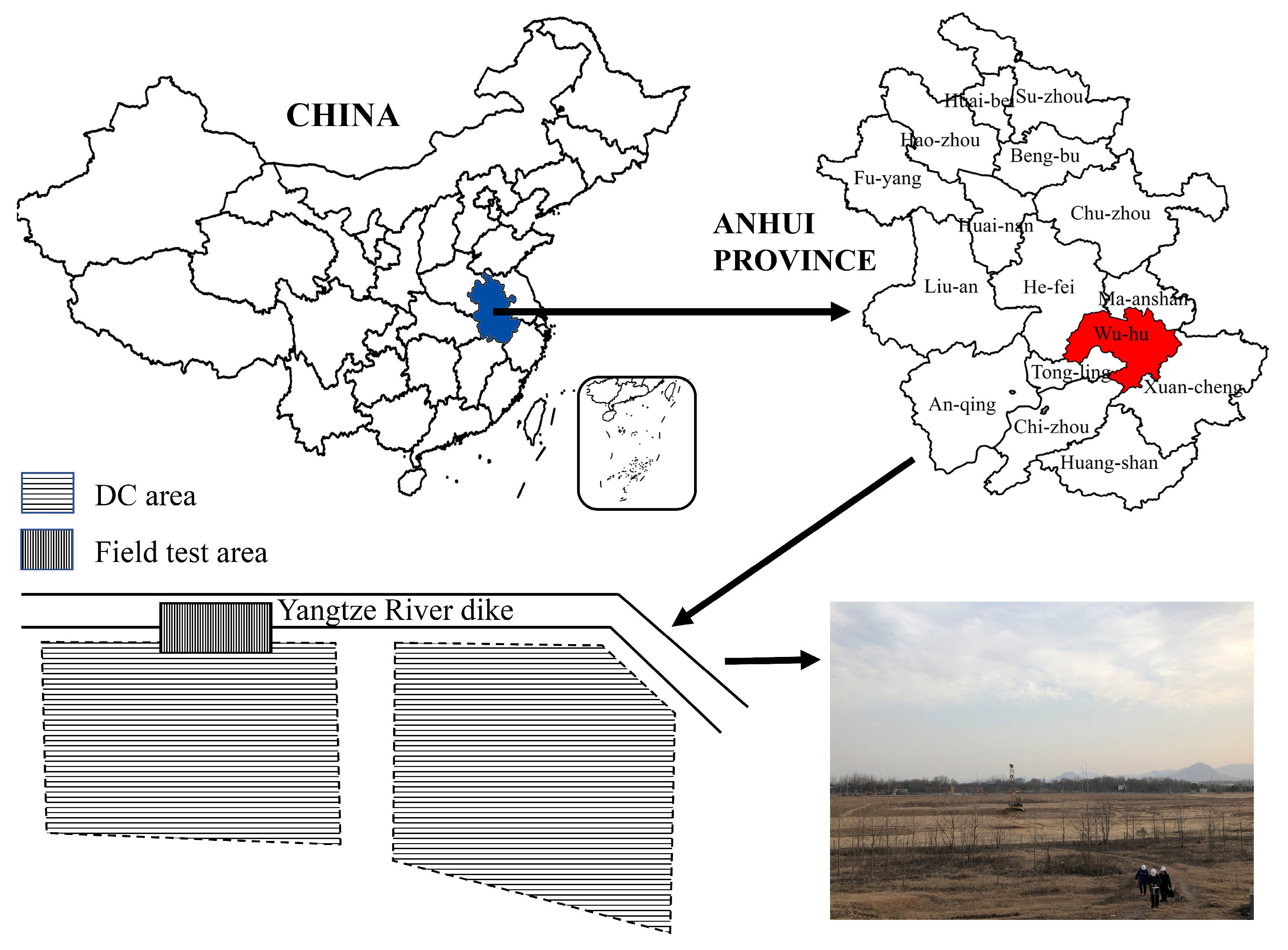
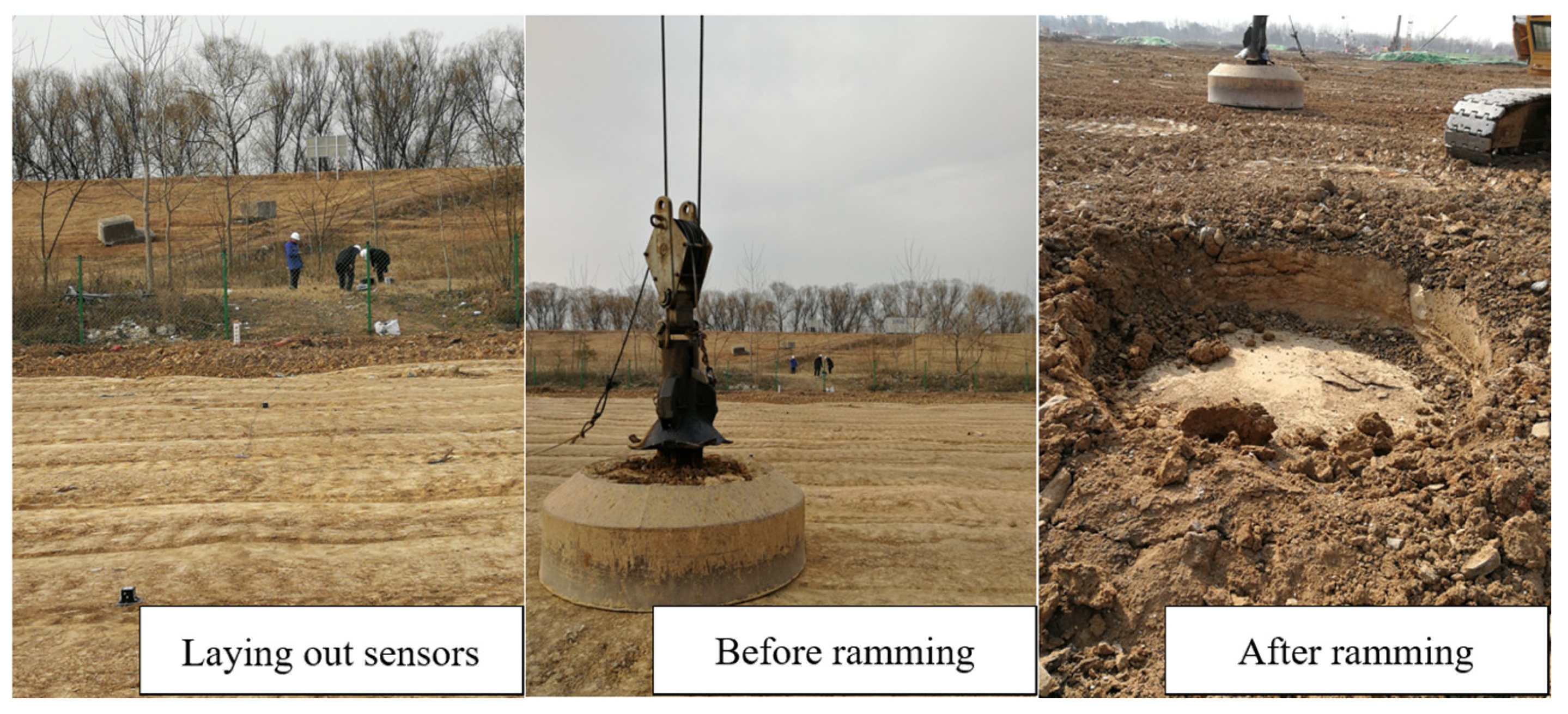
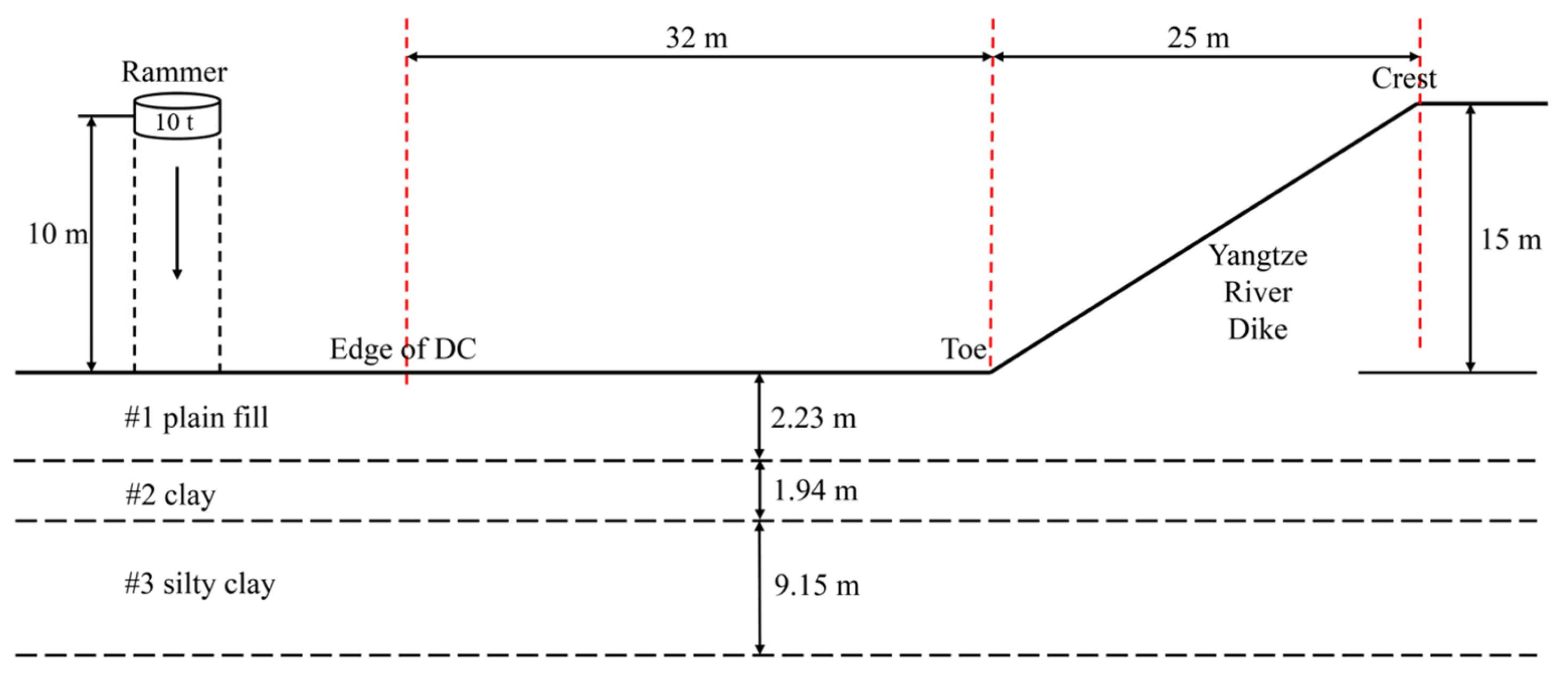

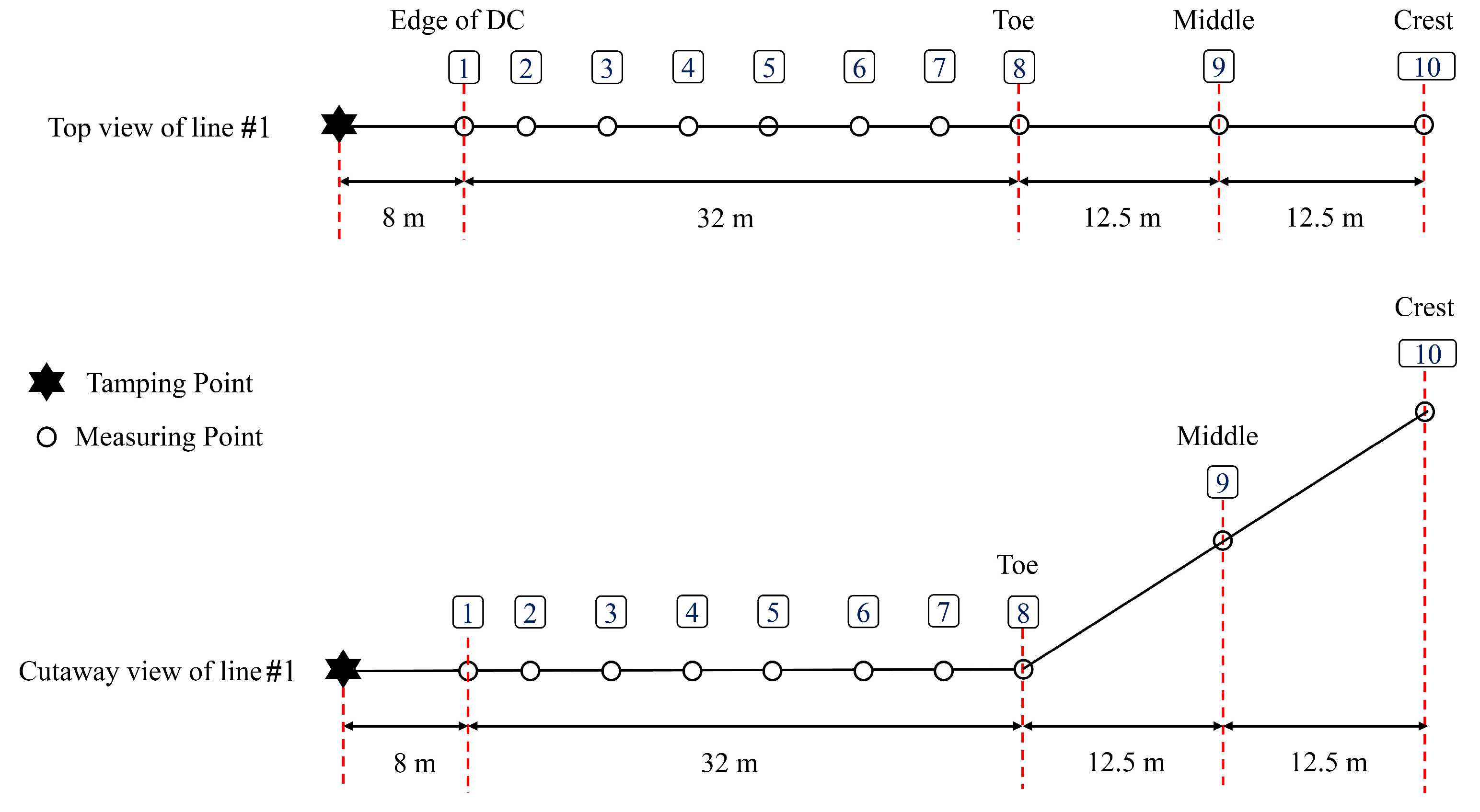

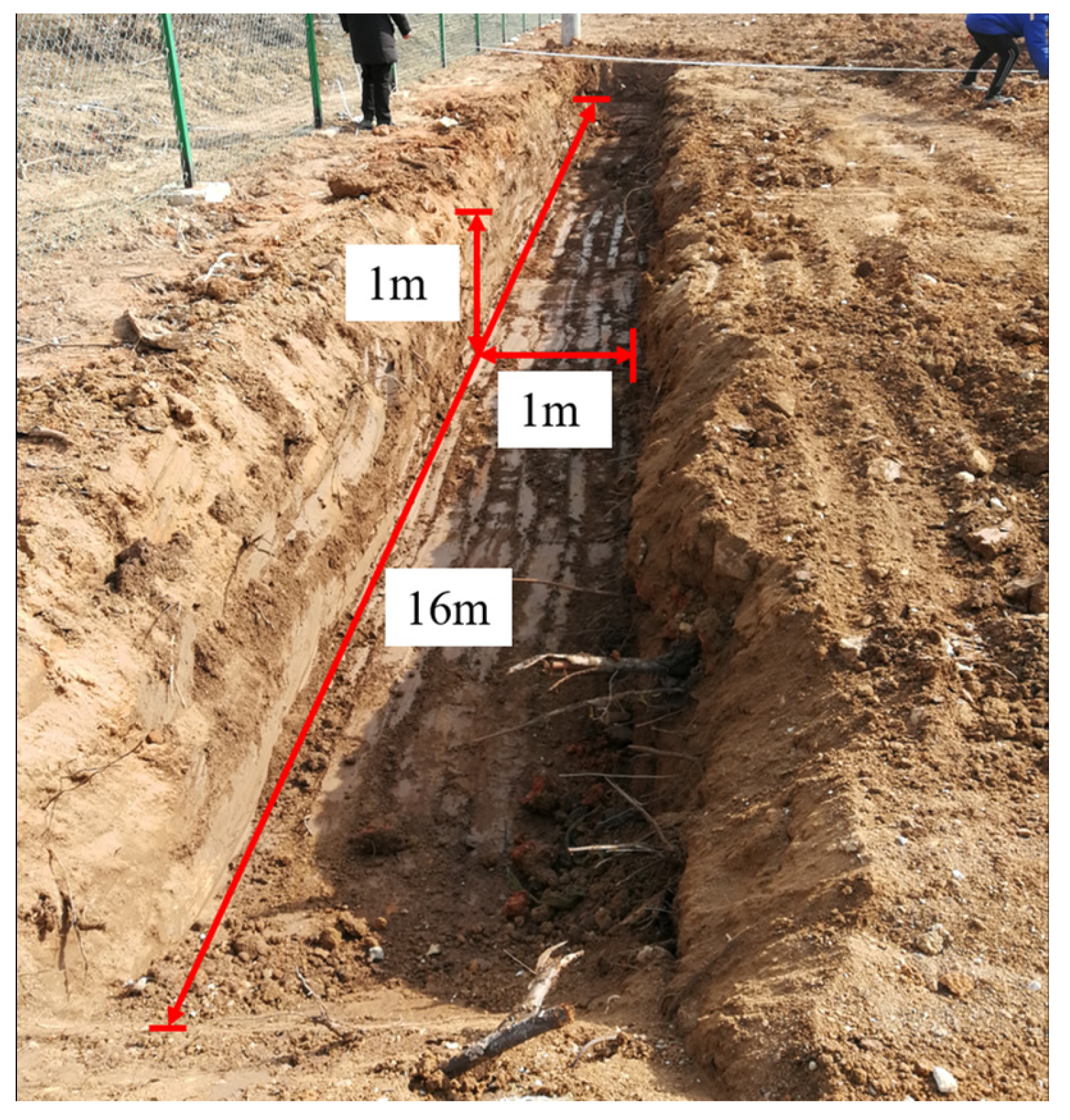
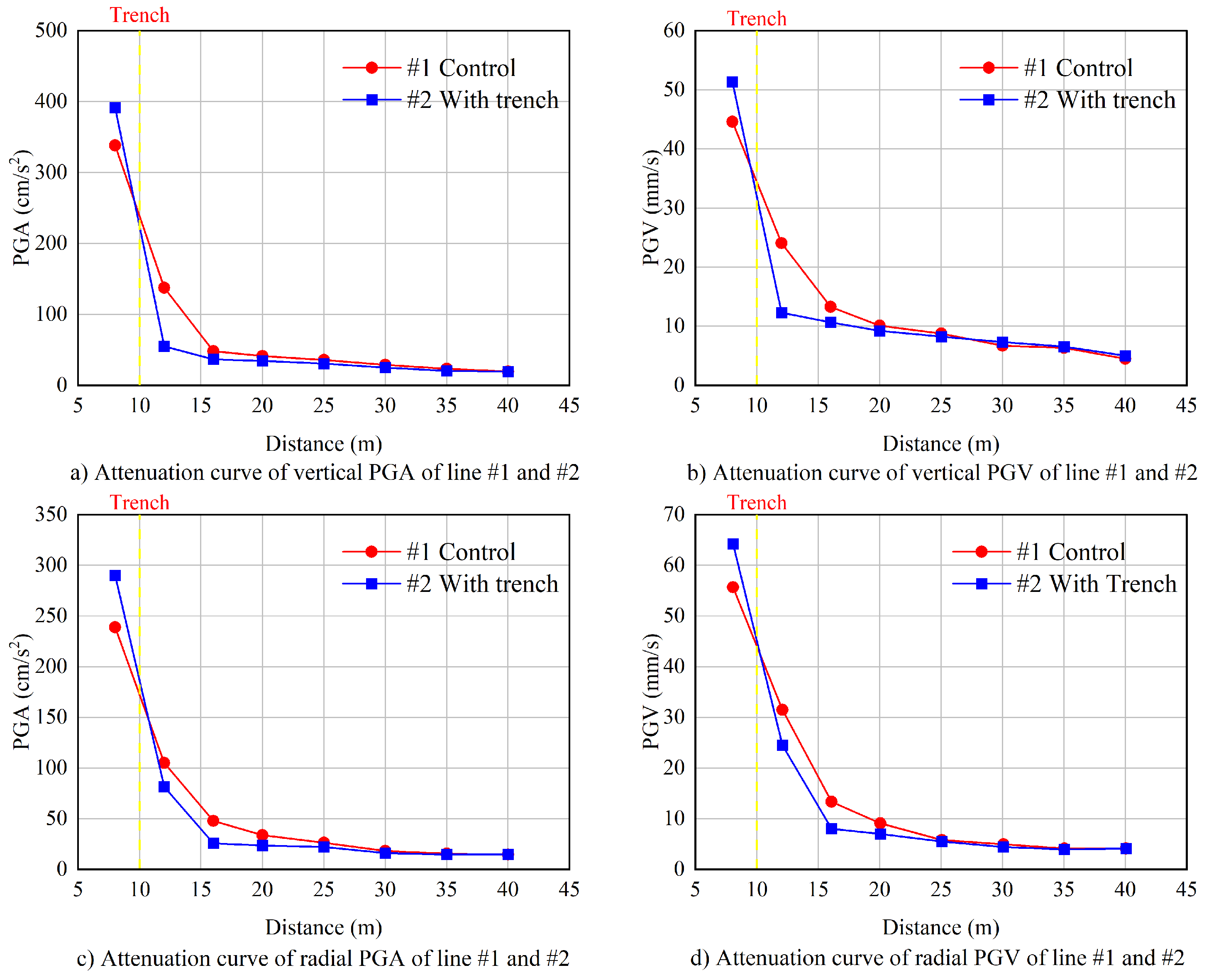
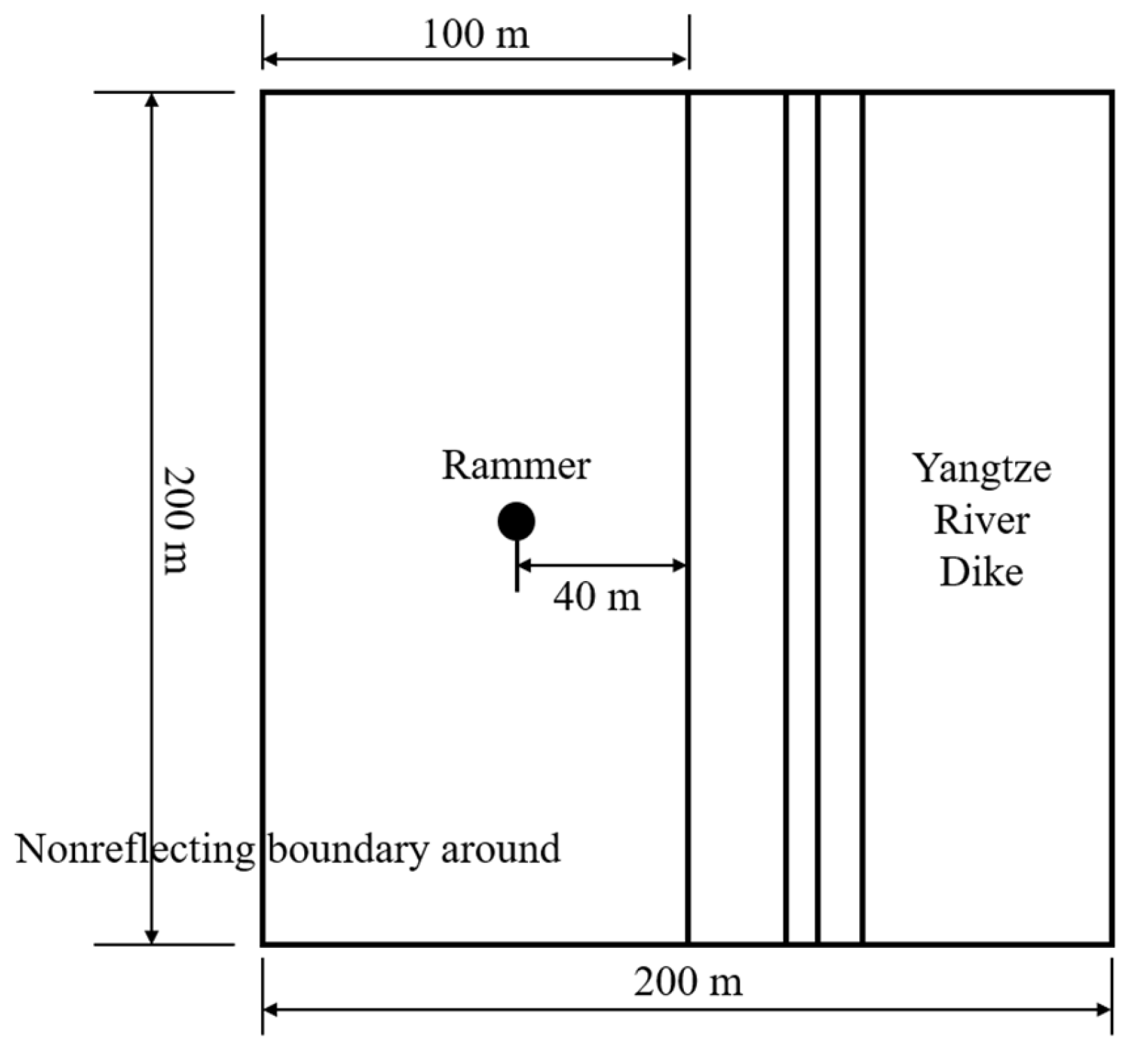
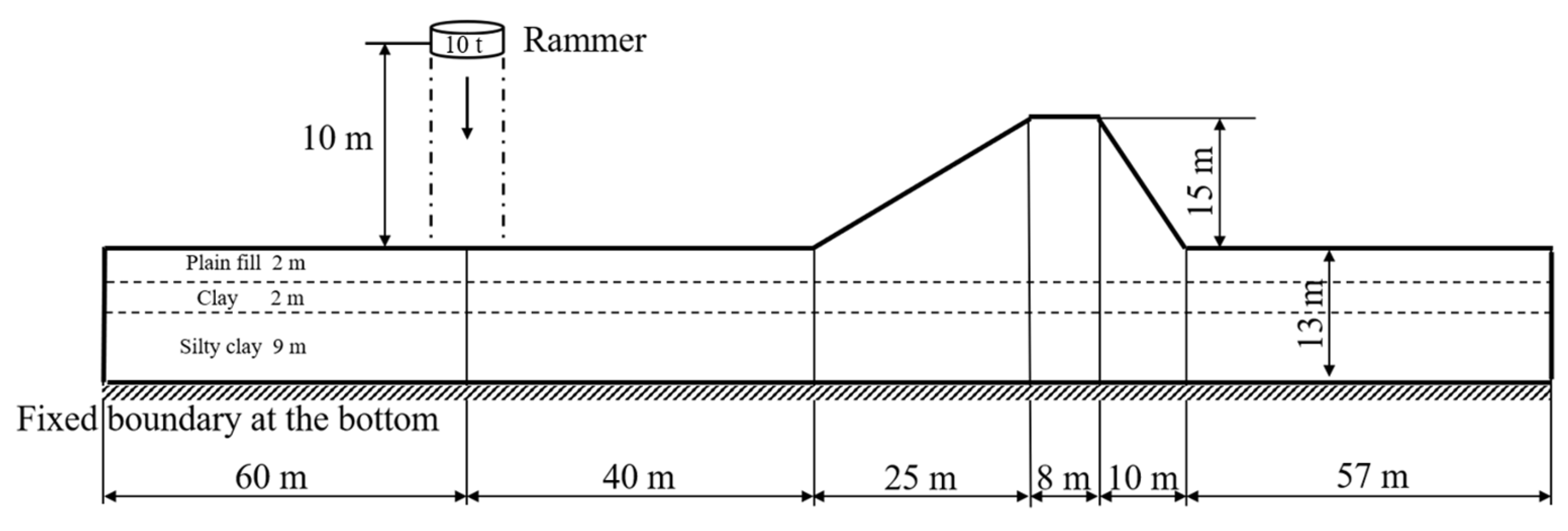
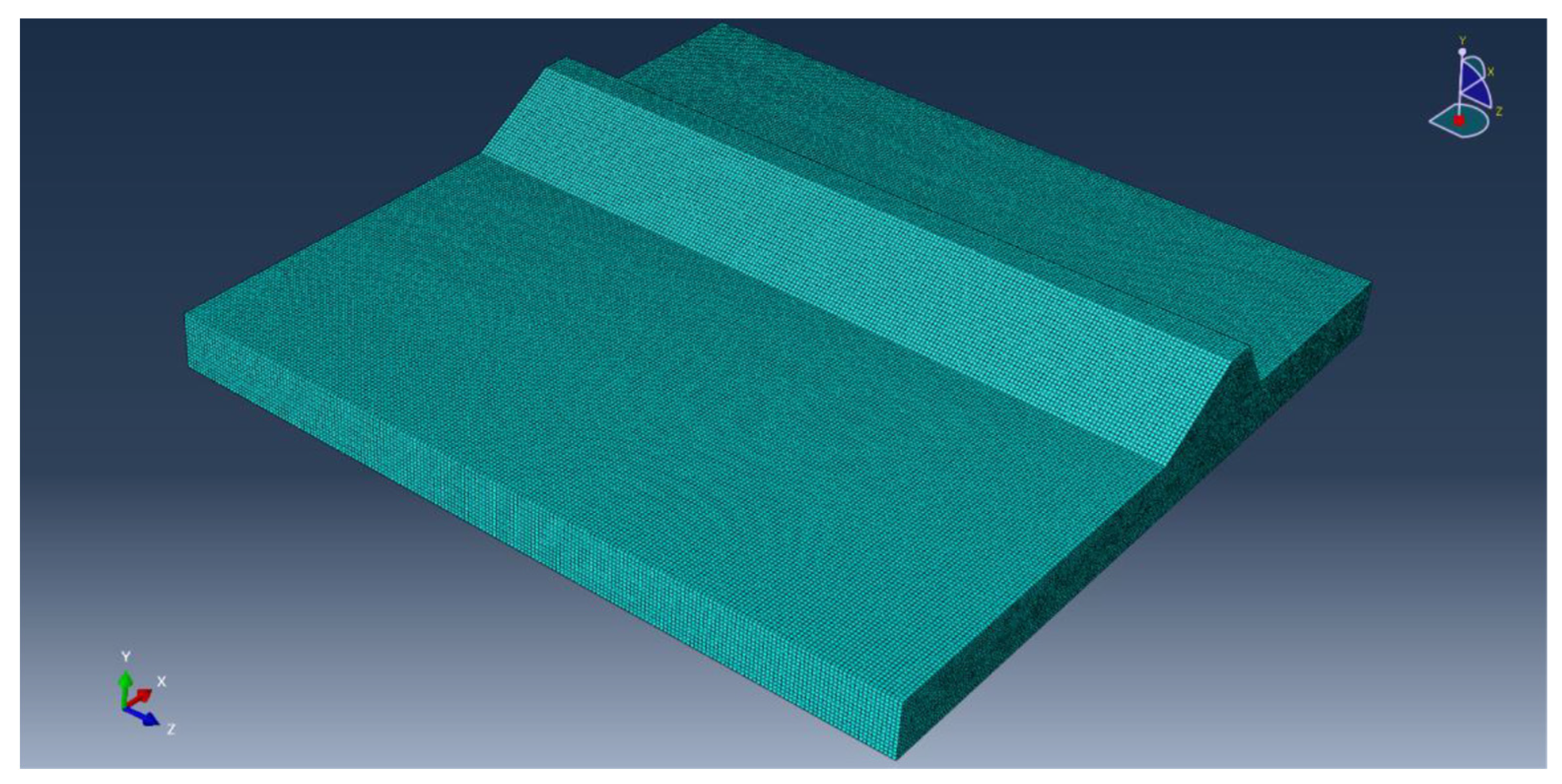
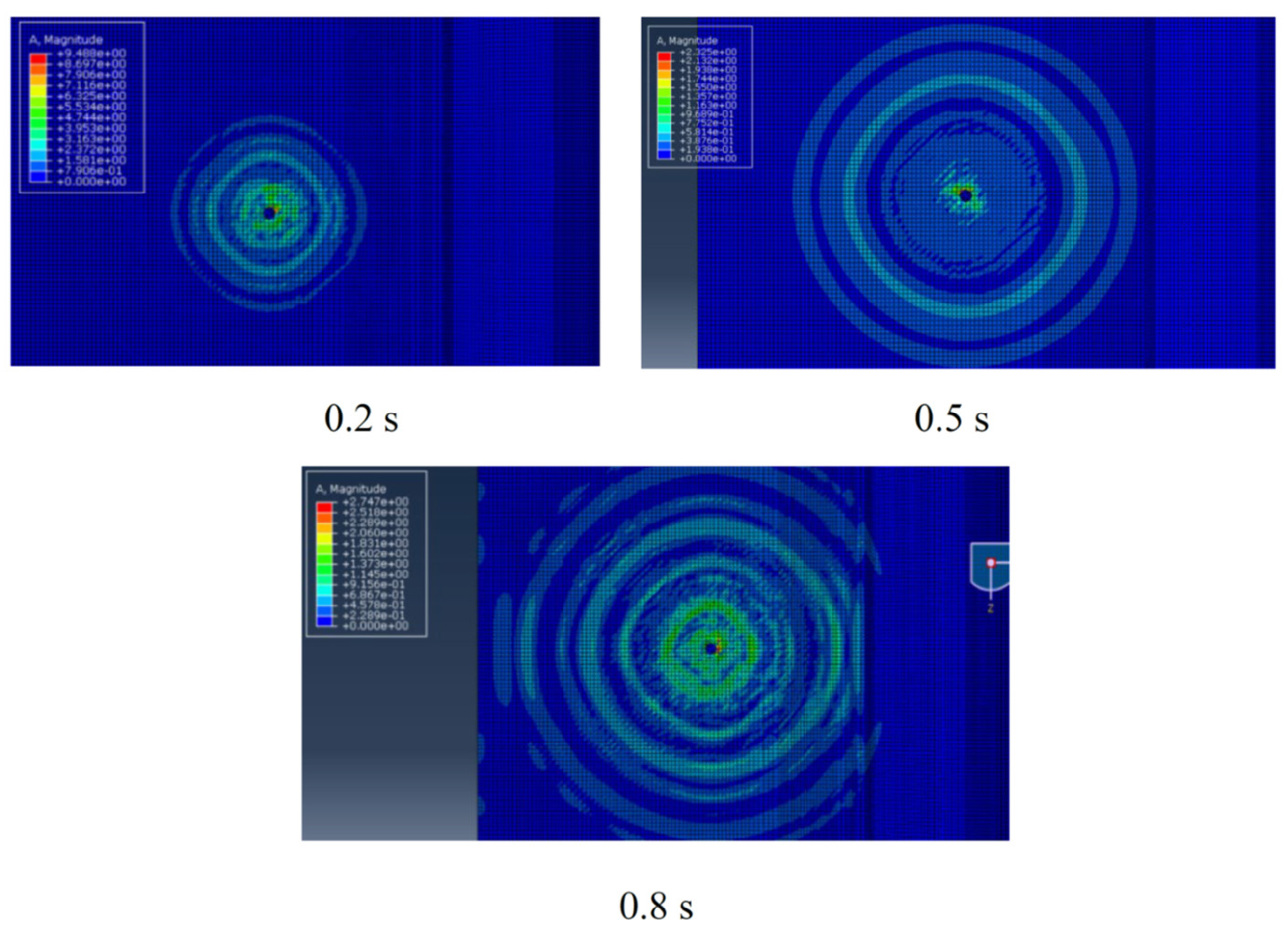

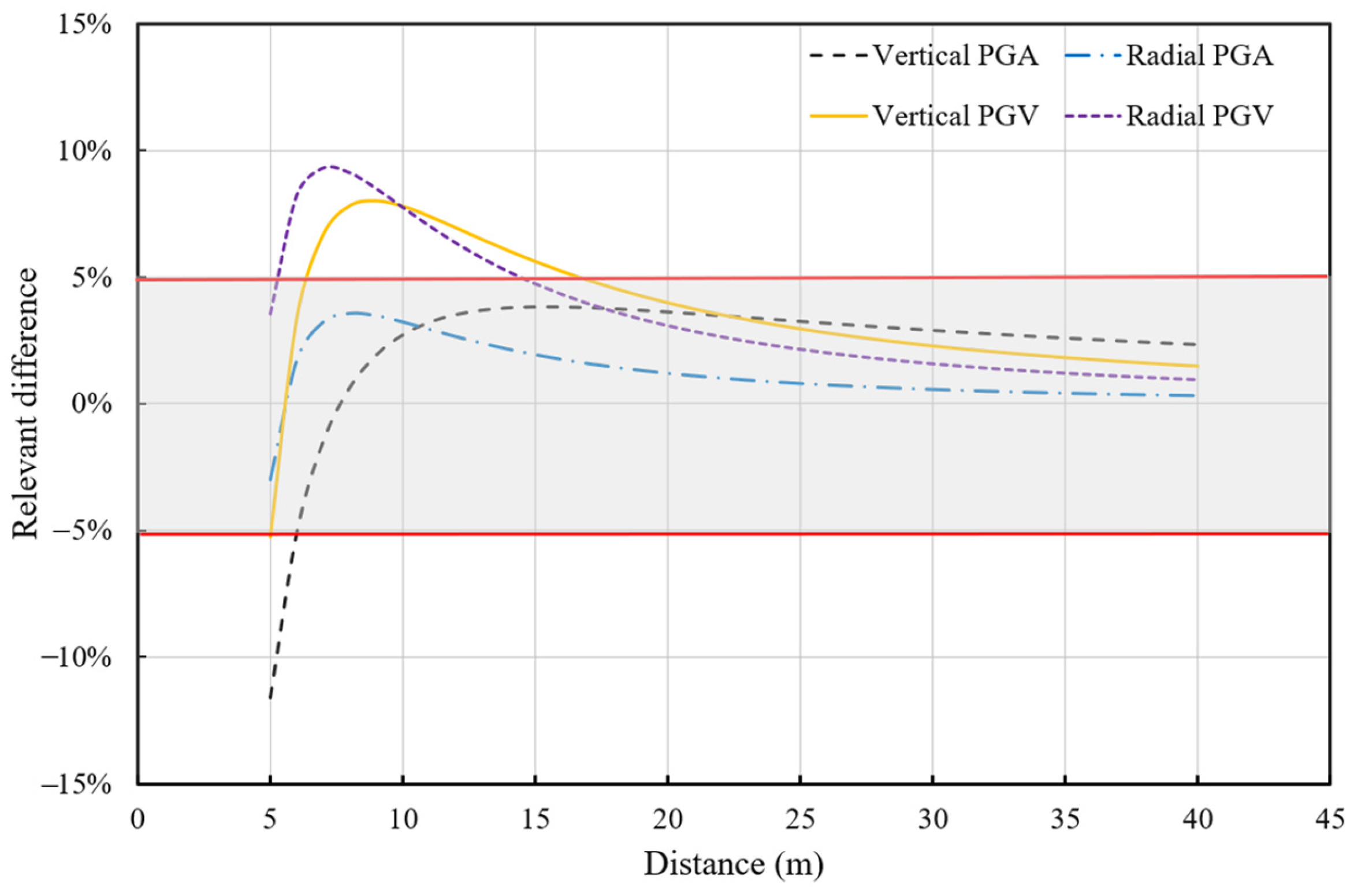

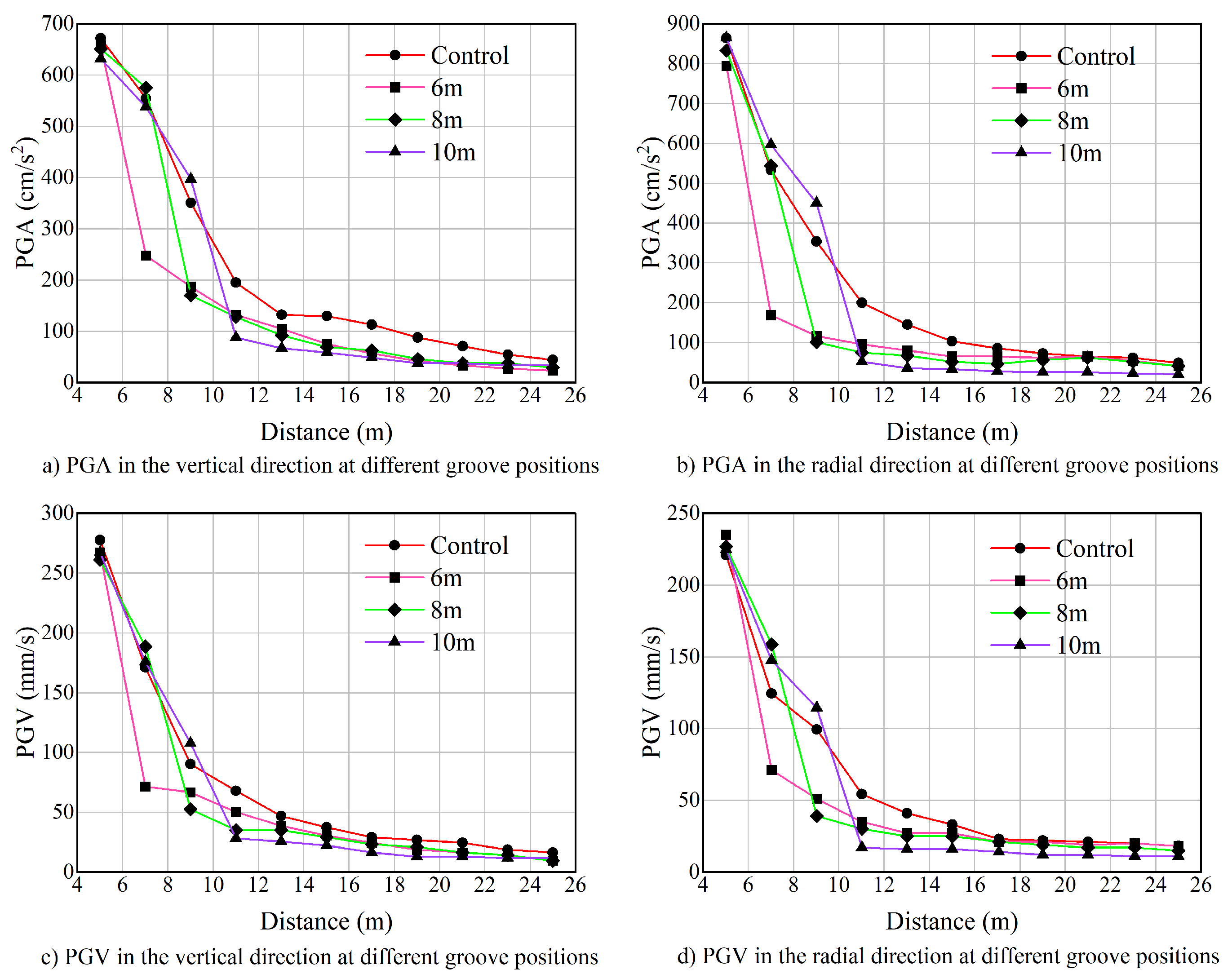
| Soil Layer | Thickness (m) | The Allowable Bearing Capacity fak (kPa) | Compressive Modulus (MPa) |
|---|---|---|---|
| #1 plain fill | 2.23 | Not suitable for direct use as a natural foundation | - |
| #2 clay | 1.94 | 100~120 | 2.83 |
| #3 silty clay | 9.15 | 50~70 | 2.86 |
| Parameters | Values |
|---|---|
| Frequency (Hz) | 1–100 k |
| Power supply | CC: ±24 V/2 mA |
| Accuracy | <1% |
| Voltage | AC: 220 V |
| No. | The Horizontal Distance between Tamping and Measuring Point (m) | |||||||||
|---|---|---|---|---|---|---|---|---|---|---|
| 1 | 2 | 3 | 4 | 5 | 6 | 7 | 8 | 9 | 10 | |
| #1 | 8 | 12 | 16 | 20 | 25 | 30 | 35 | 40 | 52.5 | 65 |
| #2 | 8 | 12 | 16 | 20 | 25 | 30 | 35 | 40 | 52.5 | 65 |
| Survey Line | Part of the Dike | Horizontal Radial | Horizontal Tangential | Vertical |
|---|---|---|---|---|
| #1 | Toe | 13.75 | 9.51 | 19.89 |
| Middle | 11.83 | 9.47 | 15.61 | |
| Crest | 5.67 | 4.24 | 10.32 | |
| #2 | Toe | 16.54 | 3.81 | 18.81 |
| Middle | 14.02 | 3.48 | 16.61 | |
| Crest | 7.62 | 3.12 | 10.98 | |
| #2 − #1 | Toe | 2.79 | −5.7 | −1.08 |
| Middle | 2.19 | −5.99 | 1 | |
| Crest | 1.95 | −1.12 | 0.66 |
| Survey Line | Part of the Dike | Horizontal Radial | Horizontal Tangential | Vertical |
|---|---|---|---|---|
| #1 | Toe | 3.64 | 2.15 | 4.85 |
| Middle | 2.59 | 2.07 | 3.78 | |
| Crest | 1.13 | 1.14 | 3.18 | |
| #2 | Toe | 3.38 | 0.94 | 4.82 |
| Middle | 2.75 | 0.83 | 4.49 | |
| Crest | 1.83 | 0.73 | 4.13 | |
| #2 − #1 | Toe | −0.26 | −1.21 | −0.03 |
| Middle | 0.16 | −1.24 | 0.71 | |
| Crest | 0.7 | −0.41 | 0.95 |
| No. | Soil Layer | Layer Thickness (m) | Density (kg/m3) | Poisson’s Ratio Internal | Friction Angle (o) | Cohesion (kPa) | Young’s Modulus (MPa) |
|---|---|---|---|---|---|---|---|
| 1 | plain fill | 2 | 1.9 × 103 | 0.35 | 15.0 | 5.1 | 2 |
| 2 | clay | 2 | 1.87 × 103 | 0.30 | 15.6 | 10.3 | 3 |
| 3 | silty clay | 9 | 1.85 × 103 | 0.30 | 17.4 | 9.2 | 3 |
| 4 | Yangtze River Dike | - | 2 × 103 | 0.25 | 20.1 | 29.8 | 5 |
| Value | Field Test | Modeling | ||||||
|---|---|---|---|---|---|---|---|---|
| PGA | PGV | PGA | PGV | |||||
| Vertical | Radial | Vertical | Radial | Vertical | Radial | Vertical | Radial | |
| k | 4704.6 | 65,887.1 | 7677.3 | 12,192.6 | 2222.9 | 33,328.7 | 2229.7 | 4848.6 |
| 1.618 | 2.748 | 2.484 | 2.588 | 1.250 | 2.348 | 1.759 | 1.988 | |
| * | 0.977 | 0.998 | 0.988 | 0.996 | 0.994 | 0.997 | 0.985 | 0.987 |
| Model No. | Distance from Tamping Point | Depth of Vibration Isolation Trench | Width of Vibration Isolation Trench |
|---|---|---|---|
| 1# (Control) | Without vibration isolation trench | ||
| 2# | 10 m | 1 m | 1 m |
| 3# | 10 m | 2 m | 1 m |
| 4# | 10 m | 3 m | 1 m |
| 5# | 10 m | 4 m | 1 m |
| 6# | 6 m | 3 m | 1 m |
| 7# | 8 m | 3 m | 1 m |
Disclaimer/Publisher’s Note: The statements, opinions and data contained in all publications are solely those of the individual author(s) and contributor(s) and not of MDPI and/or the editor(s). MDPI and/or the editor(s) disclaim responsibility for any injury to people or property resulting from any ideas, methods, instructions or products referred to in the content. |
© 2023 by the authors. Licensee MDPI, Basel, Switzerland. This article is an open access article distributed under the terms and conditions of the Creative Commons Attribution (CC BY) license (https://creativecommons.org/licenses/by/4.0/).
Share and Cite
Zheng, Y.; Lan, X.; Pan, T.; Cui, D.; Li, G.; Shen, L.; Xu, X. Field Testing and Numerical Simulation of the Effectiveness of Trench Isolation for Reducing Vibration Due to Dynamic Compaction. Appl. Sci. 2023, 13, 9744. https://doi.org/10.3390/app13179744
Zheng Y, Lan X, Pan T, Cui D, Li G, Shen L, Xu X. Field Testing and Numerical Simulation of the Effectiveness of Trench Isolation for Reducing Vibration Due to Dynamic Compaction. Applied Sciences. 2023; 13(17):9744. https://doi.org/10.3390/app13179744
Chicago/Turabian StyleZheng, Yonglai, Xin Lan, Tanbo Pan, Dingding Cui, Guangxin Li, Longyin Shen, and Xubing Xu. 2023. "Field Testing and Numerical Simulation of the Effectiveness of Trench Isolation for Reducing Vibration Due to Dynamic Compaction" Applied Sciences 13, no. 17: 9744. https://doi.org/10.3390/app13179744
APA StyleZheng, Y., Lan, X., Pan, T., Cui, D., Li, G., Shen, L., & Xu, X. (2023). Field Testing and Numerical Simulation of the Effectiveness of Trench Isolation for Reducing Vibration Due to Dynamic Compaction. Applied Sciences, 13(17), 9744. https://doi.org/10.3390/app13179744






